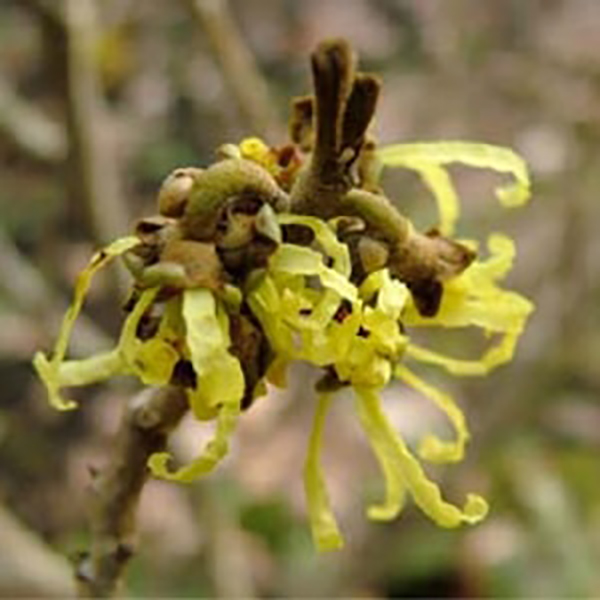
For New Englanders like me, these typical mid-winter weather conditions create a near-primal craving for spring – how much longer do we need to endure these bleak days – when will we again start to feel that welcome wakening of spring?!
Fortunately, every year around this time, that perfect remedy reliably reappears in my garden: the colorful and fragrant flowers gracing the bare branches of Asian witch-hazel (Hamamelis intermedia) gently unfurl to light-up my yard and brighten my mood. People first seeing its flowers in the otherwise-bleak mid-winter landscape often mistake it for Forsythia – but Forsythia won’t come into bloom for at least another month or more.
Hamamelis is a unique flowering shrub. Early-winter sub-freezing temperatures keep its dormant flowers tightly-held in knobby buds. Warmed by above-freezing temperatures, its spidery flower petals unfurl and then re-furl again and again (just like a New-Years-Eve-party noise-maker) as temperatures fluctuate between freeze and thaw. And typically starting around mid-February, this process continues repeatedly for three weeks or more. This year is unusual – I first saw unfurled flowers in mid-January, weeks earlier than normal, and the flowers are still spectacular now in early March!
Flower colors of witch-hazel cultivars range from the clearest yellows to rich oranges and reds, including numerous tonal variations. Size of flower, fragrance intensity and winter leaf-retention varies among the early-flowering Asian Hamamelis cultivars which include ‘Arnold Promise’ (lemon-yellow), ‘Pallida’ (sulfur-yellow, a Cary Award winner), ‘Diane’ (red), along with the native species Hamamelis vernalis (variable orange-yellow).
Note: the fall-flowering native Hamamelis virginiana (from whose leaves and bark the familiar Dickinson’s astringent solution is distilled) looks similar, but blooms in October and November rather than early spring.
Hamamelis is an easy-to-grow genus for southern New England, winter-hardy to Zone 5, enjoying rich, acid soils. Plants generally reach about 15 feet high and nearly as wide at maturity, and they grow equally well in full sun or part shade. The visual effect of grouping together differently colored cultivars is spectacular. Dozens of cultivars are available at garden centers, and you should really experience them in a garden setting.
As a horticulturist I’m continually surprised to realize how few people know about these remarkable Hamamelis hybrids. Ironically, the likely reason for its continuing obscurity is its foremost feature – witch-hazel displays its colorful blooms so early in the year, well before most garden centers are open for business. But it’s also easy for me to understand why anyone experiencing Hamamelis in full flower at this otherwise-dormant time of year immediately feels compelled to have it growing in their own yard.
Wayne Mezitt is a 3rd generation nurseryman, a Massachusetts Certified Horticulturist, now chairman of Weston Nurseries of Hopkinton, Chelmsford & Hingham MA, and owner of “Hort-Sense”, a horticultural advisory business. He currently serves in various capacities on several horticulturally-related organizations, including the Massachusetts Horticultural Society at The Gardens at Elm Bank in Wellesley MA, and chairman for the Massachusetts Invasive Plant Advisory Group (MIPAG).









